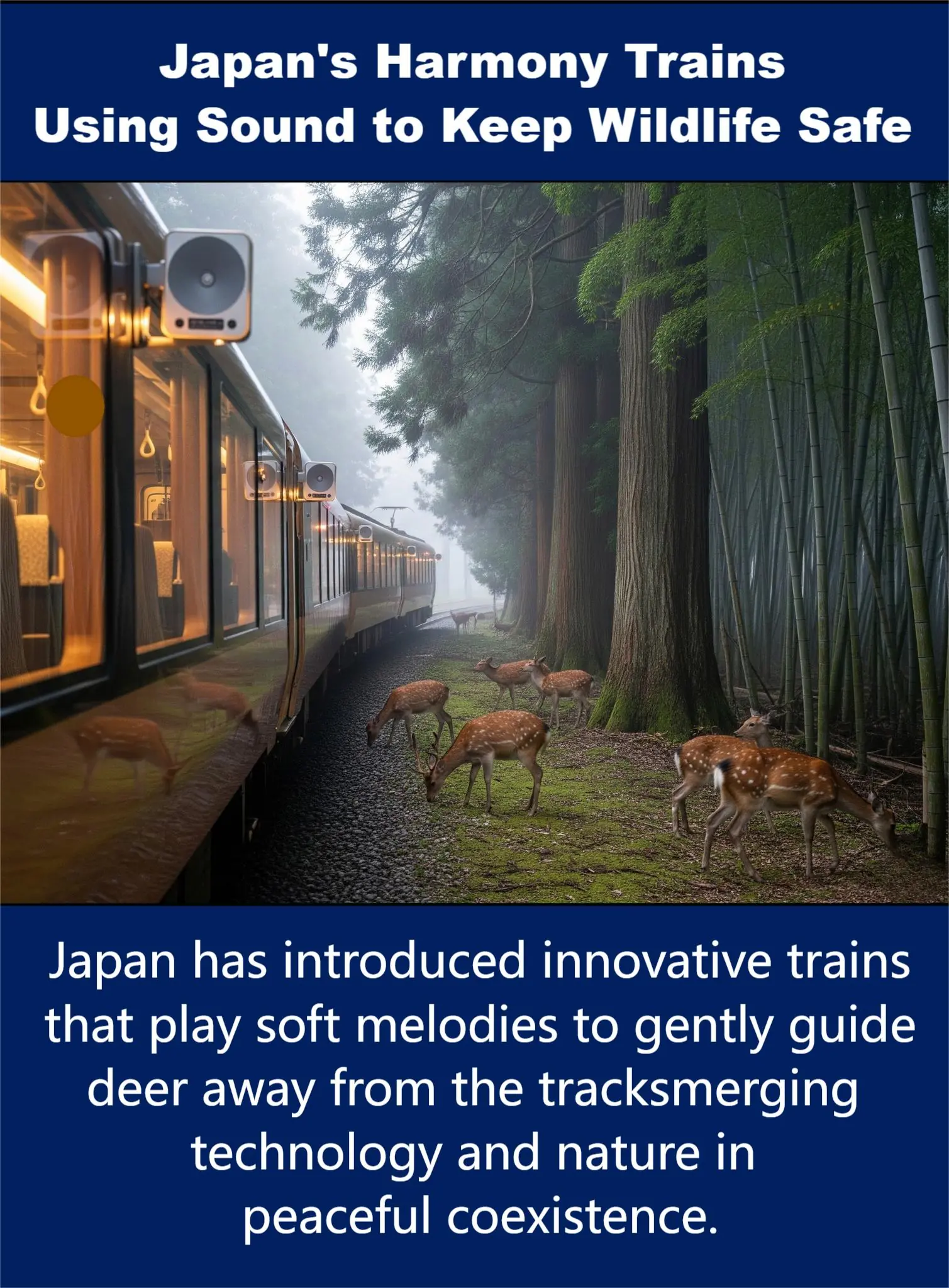
Japan’s Harmony Trains: Blending Innovation and Compassion to Protect Wildlife

In a world where rapid urbanization and technological progress often overshadow environmental considerations, Japan is setting a powerful example of how innovation can walk hand in hand with compassion. Deep in the misty forests of rural Japan, an extraordinary initiative is quietly saving lives—not human lives, but those of deer.
For decades, deer-train collisions have posed a significant problem along Japan’s more forested rail routes. These gentle creatures, often seen grazing near railway tracks, are vulnerable to sudden encounters with high-speed trains. The result has been not only fatal for the animals but also dangerous and disruptive for passengers and railway systems.
But Japan, a country where technology often complements tradition and nature, has found a remarkably humane solution: “harmony trains.”
A Sound-Based Solution Rooted in Empathy
Unlike conventional trains that rely on blaring horns to startle wildlife, harmony trains are equipped with motion sensors and external speakers. When animals—particularly deer—are detected near the tracks, the trains emit soft melodies or animal warning calls instead of loud, frightening noises. These calming sounds gently encourage the deer to leave the tracks without panic, significantly reducing the chance of collisions.
The melodies are thoughtfully chosen. Some mimic natural deer calls to simulate a sense of familiarity or danger, prompting a safe and instinctive retreat. Others are simple chimes that create an audible boundary without distressing the animals.
More Than Music: Designing a Safe Environment
The innovation doesn’t end with sound. Japan’s railway operators have also collaborated with wildlife experts and conservationists to create dedicated pathways and feeding zones that draw deer away from the tracks entirely. By diverting the animals toward safer areas with food and natural corridors, the likelihood of them wandering into harm’s way is greatly diminished.
This comprehensive approach—combining detection, communication, and behavioral guidance—underscores Japan’s commitment not just to technology, but to coexistence.
Why It Matters
According to transport authorities, train delays and damages caused by animal collisions cost millions of yen annually. But beyond the economic impact lies a deeper truth: infrastructure should not come at the expense of life, especially in ecosystems that are already under pressure from development.
Japan’s deer-safe trains represent a shift in thinking—a recognition that progress and preservation are not mutually exclusive. It’s a rare and refreshing example of how public infrastructure can be designed with empathy at its core.
A Global Model for Humane Innovation
As nations around the world wrestle with the environmental costs of modernization, Japan’s harmony trains offer a compelling blueprint. Rather than forcing wildlife to adapt to the rhythms of human convenience, Japan has shown how human systems can respectfully adapt to the rhythms of nature.
This initiative is more than a technical fix; it’s a cultural statement. It reflects a national philosophy that cherishes the balance between humanity and the natural world—a balance that many societies are struggling to regain.
Conclusion
In an age of artificial intelligence, high-speed automation, and urban sprawl, Japan’s gentle, music-playing trains are a quiet but powerful reminder that innovation doesn’t have to be loud to be revolutionary. By protecting its deer, Japan is not only saving lives but also sending a message to the world: that true progress lies in harmony—not just between people, but between people and the planet.
News in the same category


Junk Cars, Green Future: How Automobiles Became the World’s Most Recycled Consumer Product

France’s Living Streetlights: A Glowing Experiment in Sustainable Urban Lighting

Italy’s Quiet Rubber Roads: A Sustainable Shift Toward Noise-Free, Eco-Friendly Infrastructure

Earth Plunged Into Darkness For Six Minutes In Rare Event Not Seen In A Century

NASA Monitors Plane-Sized Asteroid Speeding Toward Earth at 47,000 MPH

4 Things You Should Never Say at a Funeral — No Matter What

Father of 9-year-old Melina Frattolin faces charges as new details surface in her death

🔬 Hidden Lake Beneath Greenland Ice Could Unlock Secrets of Earth—and Beyond

🔬 Scientists Discover Pink Glacial Algae Turning Arctic Snow Red—and Accelerating Ice Melt

7-Eleven Employee Dies After Being Left Brain-Dead in Shocking Incident Involving Manager

Stomach Bug Sickens Over 140 People on Caribbean Cruise, Forcing Passengers and Crew to Isolate in Cabins

🌘 The Longest Total Solar Eclipse of the Century Is Coming — August 2, 2027

🌠 Twin Meteor Showers Set to Illuminate the Night Sky July 29–30, 2025 🌠

The insights your finger length offer about your personality

The Deadly Beauty of Lake Natron: Where Nature Turns to Stone—And Flamingos Call It Home

Milaf Cola: The World’s First Date-Based Soda Could Revolutionize the Soft Drink Industry

Farting Too Much at Night

Check Your Fridge—This Popular Yogurt Brand Was Just Recalled for Plastic Contamination
News Post

🌿 Blueberry & Oreo Drip Cake Recipe

Sad pup separated from cow who raised him – camera captures tear jerking moment they reunite again

Mix these seeds in oil for long thick hair

Pear and Pomegranate Spinach Salad with Maple-Lemon Mustard Dressing

Creamy Spinach Gnocchi (20-Minute, One-Pan Meal)

Lemon Chicken Orzo Soup

🐱 What Does It Mean When Your Cat Shows You a Mouse?

🍪 Cookies & Cream Swiss Roll Cake

🍪 No-Bake Biscuit Cheesecake Bars

🍓 Strawberry Drip Cake Recipe

🍫 Ultimate Chocolate Milkshake Recipe

Experts Are Shedding Light on the ‘Death Rattle’ Phenomenon Before Passing

Junk Cars, Green Future: How Automobiles Became the World’s Most Recycled Consumer Product

France’s Living Streetlights: A Glowing Experiment in Sustainable Urban Lighting

Italy’s Quiet Rubber Roads: A Sustainable Shift Toward Noise-Free, Eco-Friendly Infrastructure

12 Warning Signs Your Blood Sugar Might Be Too Low

Why Do Some People Feel Sad After Eating White Bread?

Discover the Powers of Moringa: Traditional Recipes and Health Benefits
